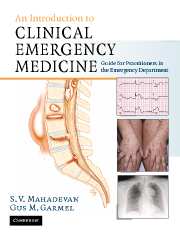Book contents
- Frontmatter
- Contents
- List of contributors
- Foreword
- Acknowledgments
- Dedication
- Section 1 Principles of Emergency Medicine
- 1 Approach to the emergency patient
- 2 Airway management
- 3 Cardiopulmonary and cerebral resuscitation
- 4 Cardiac dysrhythmias
- 5 Shock
- 6 Traumatic injuries
- 7 Prehospital care and emergency medical services
- 8 Pain management
- Section 2 Primary Complaints
- Section 3 Unique Issues in Emergency Medicine
- Section 4 Appendices
- Index
1 - Approach to the emergency patient
Published online by Cambridge University Press: 27 October 2009
- Frontmatter
- Contents
- List of contributors
- Foreword
- Acknowledgments
- Dedication
- Section 1 Principles of Emergency Medicine
- 1 Approach to the emergency patient
- 2 Airway management
- 3 Cardiopulmonary and cerebral resuscitation
- 4 Cardiac dysrhythmias
- 5 Shock
- 6 Traumatic injuries
- 7 Prehospital care and emergency medical services
- 8 Pain management
- Section 2 Primary Complaints
- Section 3 Unique Issues in Emergency Medicine
- Section 4 Appendices
- Index
Summary
The emergency department (ED) is a challenging environment for patients, families, and medical personnel. Many challenges result from our practice's principles: available at any time for any patient with any complaint. Patients who come to the ED are not familiar with us personally, yet must feel confident about our abilities to help them during their time of greatest concern. Their needs may be as straightforward as an excuse note for work or a prescription refill in the middle of the night, or as complex as an acute illness or injury, an exacerbation of a chronic condition, or a cry for help if depressed or suicidal. Even providing reassurance about a child's fever to a concerned parent is a critical function of emergency physicians (EPs).
Qualities successful EPs exhibit include intelligence, sensitivity, humility, insight, proficiency making decisions with and acting on limited information, and the ability to multi-task. Being skillful negotiators, working well with individuals having different backgrounds and ethnicities, and advocating strongly for patients at all times are essential qualities. In addition to these traits, EPs must be experts in trauma and medical resuscitation of adults and children, and in sharing news with patients and family members about the outcomes of these events.
The majority of patients use the ED infrequently. Many may be experiencing this setting for the first time. Patients' lack of familiarity with this environment, fear, stress, waiting times, painful procedures, and overall discomfort often preclude them from having a positive experience.
- Type
- Chapter
- Information
- An Introduction to Clinical Emergency MedicineGuide for Practitioners in the Emergency Department, pp. 3 - 18Publisher: Cambridge University PressPrint publication year: 2005

